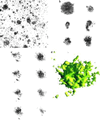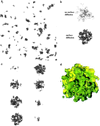Aggregation and disaggregation of senile plaques in Alzheimer disease
- PMID: 9207140
- PMCID: PMC23870
- DOI: 10.1073/pnas.94.14.7612
Aggregation and disaggregation of senile plaques in Alzheimer disease
Abstract
We quantitatively analyzed, using laser scanning confocal microscopy, the three-dimensional structure of individual senile plaques in Alzheimer disease. We carried out the quantitative analysis using statistical methods to gain insights about the processes that govern Abeta peptide deposition. Our results show that plaques are complex porous structures with characteristic pore sizes. We interpret plaque morphology in the context of a new dynamical model based on competing aggregation and disaggregation processes in kinetic steady-state equilibrium with an additional diffusion process allowing Abeta deposits to diffuse over the surface of plaques.
Figures



References
-
- Selkoe D. J Neuropathol Exp Neurol. 1994;53:438–447. - PubMed
-
- Goate A, Chartier-Harlin M-C, Mullan M. Nature (London) 1991;349:704–707. - PubMed
-
- Cai X-D, Golde T E, Younkin S G. Science. 1993;259:514–516. - PubMed
-
- de Gennes P-G. Scaling Concepts in Polymer Physics. Ithaca, NY: Cornell Univ. Press; 1979.
-
- Family F, Landau D P, editors. Kinetics of Aggregation and Gelation. Amsterdam: Elsevier; 1984.
Publication types
MeSH terms
Grants and funding
LinkOut - more resources
Full Text Sources
Medical

